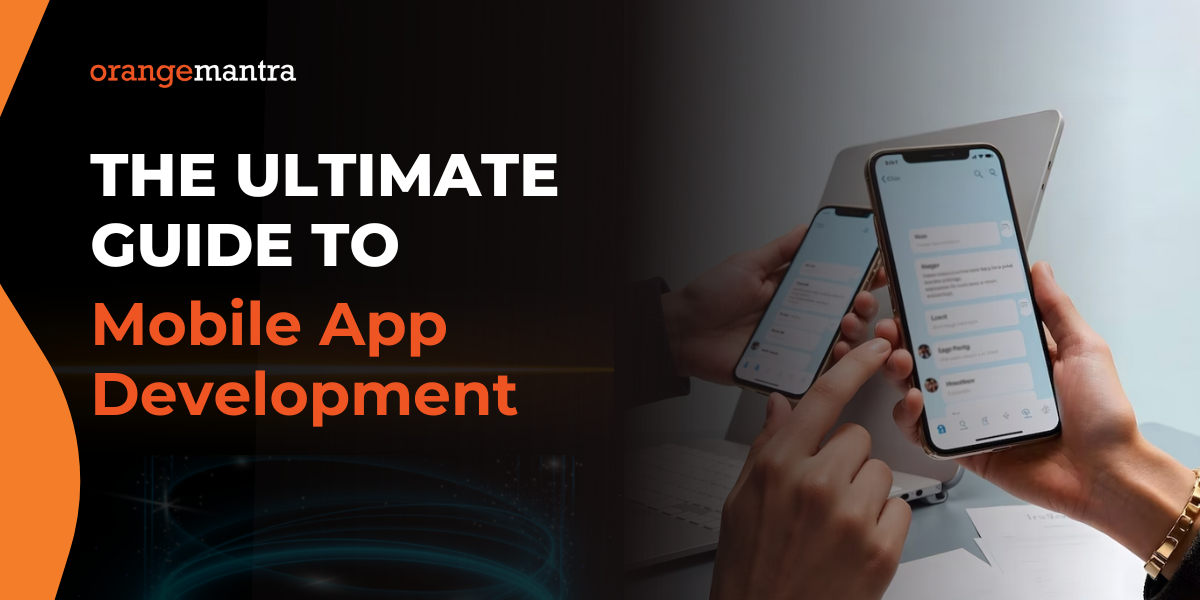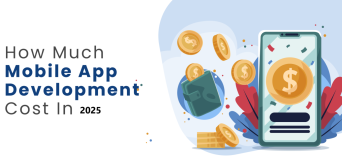
Here’s what you will learn:
In today’s digital age, mobile app development has become a core part of both our personal and professional lives.
From booking cabs to ordering food from your favorite restaurant, from reconnecting with old friends on social media to paying your local vegetable vendor – mobile apps are doing it all for you.
The growing use of smartphones has pushed business owners to move beyond just websites and invest in mobile apps too. But here’s the thing – mobile app development isn’t standing still. It’s constantly evolving, driven by new tech, changing market trends, and rising user expectations.
No business wants to lose customers just because they don’t have a mobile app or worse, they have one that’s not up to the mark.
And if you’re still wondering if mobile apps are worth the hype – Statista reports that global mobile app revenue is expected to hit a jaw-dropping US$781.70bn by 2029. Now that’s a number you can’t ignore.
Table of Contents
Mobile App Usage in Numbers
The second quarter of 2024 saw a huge increase in global consumer spending on mobile apps through the Apple App Store and Google Play. The number was $32.4 billion in 2023 and reached $36.2 billion (12% more).
There are around 5 billion smartphone users across the globe. Users are spending an average of 3 hours and 45 minutes online on their smartphones every day.
So, there is no doubt that the industry is expanding. Global mobile apps users are now growing steadily. And it’s a trend analysts say will continue throughout the decade.
- The average smartphone user spends 90% of their mobile time on apps, with a mere 10% spent surfing the web.
- Mobile apps can be developed on multiple platforms to reach the largest potential audience and maximize revenue.
- Android has nearly 3.5 million apps while iOS users can choose from just 2.2 million apps.
- Half of the applications available on the App Store have never been downloaded.
- Thousands of apps are released daily.
- Android is the most popular mobile operating system in the world, having a 71% market share.
- Apple’s iOS market share is approximately. 27.65%.
- Over 60% of shoppers prefer shopping on mobile apps rather than desktop websites.
As you can conclude from these stats, investing in the mobile application development process could open new business opportunities.
But remember that your mobile app will be competing with over 2 million applications on app stores.
Why a Strategic Mobile App Development Process Matters for Business Success?
You are aware of how a mobile app development company could benefit businesses. And those benefits go beyond just the short-term bottom line. Digital engagement could pave new ways for long-term customer engagement and loyalty.
When you invest in well-structured iOS and Android app development projects, you’re planning for the long shot. While a staggering number of small and large businesses have taken advantage of mobile, some are yet to have the right strategy in place.
Success can become a reality for your enterprise, but only if guided by an expertly crafted mobile application development process. So, without further ado, let’s discuss the distinct phases of mobile application workflow and development step by step.
Regardless of the size and scope of mobile applications, the below information will make mobile apps a sure shot success.
A Complete Mobile App Development Overview in Simple Words
From a technical point of view, building a mobile app is all about creating software that runs on mobile devices and can be downloaded and installed from app stores.
But it’s more than just coding. You need to consider screen sizes, platform compatibility, features, designs, and more.
That’s why it makes sense to hire mobile app developers who understand your requirements and know how to bring them to life.
There are mainly three types of mobile apps: Native, Hybrid, and Cross-Platform. In this guide, let’s walk through the essential steps involved in mobile app development.
Mobile App Development Process Step-by-Step
Step 1: Pre-Development Planning
A poor app experience leaves a bad first impression, and users won’t give your app a second chance. So, it’s important to get it right the first time.
This phase is about building a solid foundation before you start designing or coding. It gives you a roadmap that makes the entire process easier and more effective.
Why Pre-Development Planning Matters:
- Helps estimate the budget
- Makes strategy planning smoother
- Reduces scope for mistakes and confusion
- Aligns the entire team toward clear goals
Step 2: Strategy and Market Analysis
This is the part where your app idea takes a more refined shape. Different businesses have different goals, so the strategy should match your specific needs.
Here are the key questions you need to answer during this step:
- What’s the Objective of Your App?
- Does your brand really need a mobile app?
- What problem will the app solve?
- Is it aligned with your business model?
- Do you have the budget and timeline figured out?
Who’s Your Target Audience?
Without knowing who your users are, you’re shooting in the dark. Analyze trends, demographics, and behaviors to define your ideal audience.
What Features Should the App Have?
Now that you know your audience, identify what matters most to them:
- What features will make their lives easier?
- How does your app improve engagement?
- What makes it better than your competitors?
What’s the Competition Doing?
Look at similar apps. Learn from their strengths and flaws. This helps you create a better experience and avoid mistakes.
Do You Have a Marketing Plan?
Even the best app can flop without marketing. Plan how you’ll promote the app, what platforms you’ll use, how you’ll pitch it, and how you’ll measure success.
Step 3: UI/UX Design
A great app doesn’t just function well, but it also feels right. That’s what UI/UX design is all about. If users find your app hard to navigate or inconsistent, they’ll leave in seconds.
Here’s how to keep things user-friendly and intuitive.
1. Define the Features & Flow
Before jumping into visuals, map out how your app will work. What features should be included, and how should users interact with them?
2. Create Wireframes
These are the basic blueprints of your app layout. Wireframes show how each screen will be arranged without the actual design details.
3. Add a Style Sheet
This includes your app’s visual language – colors, fonts, icons, and styles. It keeps the look consistent and matches your brand identity.
4. Build Mockups
Think of mockups as a polished version of the wireframes. Now you can see how your app will actually look with all the design elements in place.
5. Develop Prototypes
A prototype is an interactive demo. It simulates how the app will work and helps you spot usability issues before development starts.
What Tools & Techniques Are Used in the App Development Process?
Once you’ve completed the research, planning, and design for your mobile app, the app development phase begins. This is when the actual coding starts.
It’s important to choose the right technologies for your app’s backend, API, and frontend.
The right tools and techniques ensure your app runs efficiently and delivers a smooth user experience. In this section, we’ll dive into the key components involved in the mobile app development process
1. Backend Development
The backend, also known as server-side development, is where all the magic happens in terms of data storage, security, and processing. The backend is critical to the app’s performance, stability, and overall success.
Without the right backend technology, your app may face issues like slow performance, security vulnerabilities, and lack of scalability.
Popular Backend Technologies for Mobile App Development:
2. API Integration
The API (Application Programming Interface) is the bridge that allows different software components within your app to communicate with each other and other external apps.
It facilitates seamless data exchange, enabling features like login with Facebook or integration with third-party apps. API integration are essential for enhancing user experience and ensuring that your app can connect to various services, platforms, and databases.
Why APIs Are Crucial for Mobile Apps:
- For smooth data sharing and integration with external services
- Provide a secure method for users to interact with your app’s features
- Allow for easier scalability and flexibility
3. Frontend Development
The frontend is the visual part of the app. It is the interface that users interact with. A well-designed frontend is essential for keeping users engaged and ensuring a positive user experience.
The frontend should be visually appealing and easy to navigate. It’s the key to retaining users and reducing churn.
Techniques for Effective Frontend Development:
- A Design that looks and works well across different devices and screen sizes.
- The usability and aesthetics of your app to enhance user interaction.
- Tools like React Native, Flutter, and Vue.js are commonly used to build smooth and fast mobile interfaces.
Why Choose Native App Development?
Native app development means creating apps specifically for iOS and Android. This approach involves building separate codebases for each platform, which can be costly and time-consuming.
But in return, you get top-notch performance and superb functionality tailored to each platform.
Tools for iOS Development: Objective-C, Swift, Xcode
Tools for Android Development: Java, Kotlin, Android Studio
Also Read: Best 15 Mobile App Development Frameworks
Why Go for Cross-Platform App Development?
Cross-platform development lets you write one codebase that works on both iOS and Android. It’s all about the “write once, use everywhere” concept.
This approach saves time, reduces costs, and helps you reach a wider audience with less effort.
Popular Tools for Cross-Platform Development:
Ionic, Flutter, Cordova, Xamarin, React Native, PhoneGap
Also Read: A Guide to iOS App Development
Why Consider Hybrid App Development?
Hybrid app development is a combination of web apps and native apps. It brings you the best of both worlds – faster development, better scalability, and easier maintenance.
Hybrid apps can deliver performance and user experience close to native apps, but with a more streamlined development process.
Languages Used for Hybrid Development:
HTML5, CSS, JavaScript
Why is Testing Essential in Mobile App Development?
Testing is a key part of the mobile app development process. It helps make sure everything works perfectly before the app goes live.
Without proper testing, the app can end up with bugs, poor performance, or security issues, leaving users frustrated.
A solid quality assurance (QA) process is important to guarantee a smooth experience and top performance. Here’s why testing matters:
User Experience (UX) Testing
UX testing is all about making sure the design is user-friendly. The goal is to ensure the app looks and feels just like the prototype you designed in the pre-development phase.
The colors, style, navigation, and data structure all need to work well to give users an enjoyable experience. It’s important that users don’t struggle with using the app. It should feel natural.
Functional Testing
Functional testing checks if everything works as it should. Every feature needs to be tested to ensure that it functions properly, especially when used by many people at the same time.
If there are any bugs or issues that could affect the app, functional testing helps find and fix them. It makes sure everything is running smoothly when the app is launched.
Performance Testing
Performance testing is about how well your app handles pressure. It tests the speed, app size, battery usage, and response time when multiple users are on the app at once.
The goal is to make sure the app loads quickly and doesn’t drain the phone’s battery. It’s all about giving users a smooth experience, no matter how many people are using the app.
Security Testing
Security testing is important, extremely if your app deals with sensitive user data or payment information. This test checks for vulnerabilities. It keeps your app safe from hackers or viruses.
It’s important to protect your users’ data, and if your app has payment features, you’ll need extra security to keep financial information safe.
What Are the Key Post-Development Steps?
Once all stages of your mobile app development are done, it’s finally time to launch your app. But the job doesn’t end there.
Deployment and post-launch maintenance are just as important as the development itself. Here’s what comes next:
1. App Deployment
To make your app live on platforms like the Google Play Store and Apple App Store, you’ll need an experienced mobile app developer who knows the submission process inside out.
So, you need to hire an Android or iOS developer depending on the platform you are launching your app.
Here’s the basic info required to submit your app:
- App title
- App description
- Relevant keywords
- App category/type
- App icon or thumbnail
- Screenshots of your app
iOS Apps: Apple has a strict review process. Your app must meet their guidelines before it gets approved and listed.
Android Apps: Google Play Store is a bit more flexible. You can publish your app without a review, and it becomes available for download in just a few hours.
2. Maintenance & Support
Once your app is live, ongoing support becomes very important.
- Keep track of important metrics like downloads, crash reports, and user retention.
- Pay attention to feedback – reviews, ratings, and comments can help you spot issues early.
- Fix bugs and roll out regular updates to improve features and keep the app fresh.
- Stay on top of the latest tech trends and user needs so you can adapt your app accordingly.
Also Read: How is AI Shaping the Future of the Mobile App Development Market?
Mobile App Development Cost in 2025
If you’ve ever Googled “How much does mobile app development cost in 2025?” – you’re not alone. It’s one of the most common questions businesses ask before starting their app journey.
And here’s the honest answer: it depends on what you’re building, who’s building it, and how complex the features are.
But to give you a realistic ballpark:
Simple mobile apps with basic features and complex backend can be developed for between $10,000 – $25,000. Think of apps like a basic calculator, to-do list, or a simple company catalog.
Medium complexity mobile app with custom UI, third-party integrations, moderate backend can cost anywhere between $25,000 – $60,000.
Some examples of such mobile apps are a food ordering app, fitness tracker, or eCommerce app with user accounts and payments.
Complex mobile apps having real-time features, advanced backend, custom APIs, dashboards, or let’s say AI/ML features can cost up to $150,000+.
The average starting mobile app development cost for such app starts at $60,000. These could be social media platforms, finance apps, ride-sharing apps, or on-demand service platforms.
What Drives the Cost of Mobile App Development?
Let’s break down the key mobile app development cost factors so you know what to expect:
App Type
- Native apps (built separately for iOS and Android) cost more but offer top-tier performance.
- Cross-platform apps like those built with Flutter or React Native save time and money with a shared codebase.
- Hybrid apps fall somewhere in between.
Features & Functionality
Each new feature adds development hours. A login system, in-app chat, real-time tracking, payment gateway. All these take time to build, test, and integrate.
Design Complexity
Are you going with a clean, minimalist UI or a feature-rich custom design with micro-interactions and animations? The more design effort required, the higher the mobile application development cost.
Backend Infrastructure
Apps that need a strong backend for real-time data syncing, user management, or data analytics require more effort on the server side. This adds to the mobile app cost.
Third-Party Integrations
Want to integrate Stripe, Firebase, Maps, social login, or CRM tools? Yes, they are useful. But each integration requires development time, testing, and sometimes licensing costs.
Development Team Location
Where your development team is based makes a big difference. This is because the location decided the minimum wage. Here is the average cost of developing mobile apps in different parts of the globe.
- US, Canada, Western Europe: $100 – $250/hour
- Eastern Europe, Latin America: $40 – $100/hour
- India, Southeast Asia: $20 – $50/hour
Remote teams from regions like India offer excellent quality at more affordable rates especially for startups and SMBs working on tighter budgets. So, it could be a smart decision to take mobile app development services in India.
Note: The mobile application development cost provided here is for references purpose only. Just take the idea from here as the actual cost may vary. Contact us to know our cost.
Also read our detailed article on Mobile App Development Cost in 2025
Wrapping It Up
Mobile app development isn’t just about writing code. It’s about solving real problems, building something useful, and creating experiences your users won’t forget.
Every step matter from planning and design to development, testing, and post-launch support; you cannot ignore a single one of these.
What truly sets a successful app apart is strategy. Having the right tech stack, understanding your audience, refining the user experience, and constantly improving after launch is what takes an app from “just another download” to something people actually use and recommend.
In today’s mobile-first world, business needs to have a mobile app.
So, whether you’re planning to build a native, hybrid, or cross-platform app, the key is to approach it with clarity, creativity, and a user-first mindset. Build it right, and your app could be the next big thing your users love and your business grows with.
Frequently Asked Questions
1. How much time does it take to develop a mobile app?
The timeline totally depends on the complexity of the app. A simple app with basic features might take 2 to 3 months. If your app is more feature-rich it could take 4 to 6 months or longer. We focus on quality and user experience, so we never rush the process.
2. Do you ensure the security and confidentiality of my app idea?
Absolutely. Your app idea is safe with us. We follow strict protocols to protect your concept, data, and business insights at every stage of the development process.
3. Do you offer post-deployment support and maintenance?
Yes, we do. Launching the app is just the beginning. We offer post-launch support, updates, and regular maintenance to keep your app secure, up-to-date, and running smoothly.
4. Do you sign an NDA?
Yes. If required, we’re happy to sign a Non-Disclosure Agreement before getting into any detailed discussions. Your trust matters, and we take confidentiality seriously.


